Kansas City Royals Continue Hunt for Elusive Starting Pitching

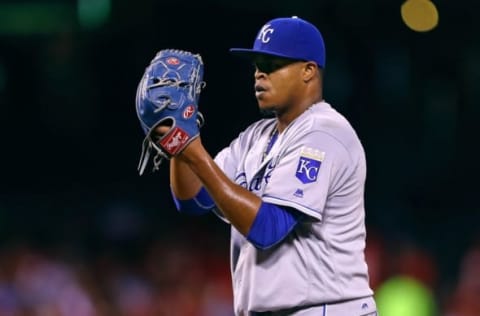
The Kansas City Royals have built a contending ballclub on the strength of timely hitting, stellar defense and a strong bullpen. However, starting pitching remains a gaping hole that they have not been able to fill internally.
The past two seasons have been great for fans of the Kansas City Royals. After two decades of being irrelevant, the Royals made the 2014 World Series, coming one game short before returning last year and ending their 30 year championship drought.
Along the way, they have changed the way teams build their rosters. A squad built upon putting pressure on opposing defenses, stellar defense and a bullpen that was the envy of the rest of baseball, the Royals kept finding ways to win. It may have been unconventional at the time, but now teams like the New York Yankees and Houston Astros have attempted to emulate that approach to the relief corps.
However, the Royals have had one constant weakness over the past few years with their starting rotation. Those issues have continued this year, as the Royals rank 25th in baseball with a 4.96 ERA heading into today’s slate of action, and are 28th with 484 innings pitched, ranking ahead of only the Orioles and the Reds. Once again, the Royals bullpen has had to pick up the slack.
As such it is no surprise that, once again, the Royals are being linked to various starters on the trade market. Nick Cafardo of the Boston Globe mentioned that they are linked to old friend Ervin Santana, as well as the Rays Matt Moore and the A’s Sonny Gray. Although these players would be more than just a rental, the cost would be quite steep, especially for Gray.
What has gone wrong for the Kansas City Royals as they have been unable to solidify their rotation? Let us take a look back over the past few years.
Next: The initial candidates
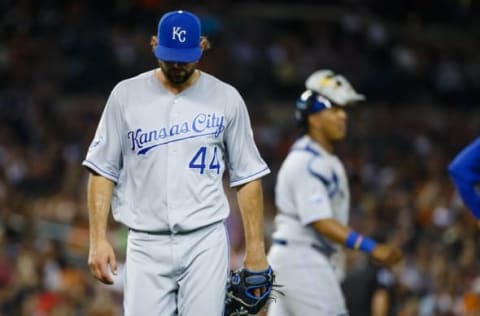
The Dark Ages
To understand how the Kansas City Royals found themselves in this situation, let us go back over the past few years. In looking at their pitching prospects, the last true ace that they developed on their own was Zack Greinke, who won the 2009 Cy Young award and later became one of the pieces that Dayton Moore would move to construct his championship ballclub.
Since that point in time, there have been a number of promising minor league arms that were expected to take on that role. Pitchers such as former number one overall draft pick Luke Hochevar and Aaron Crow failed as starters, transitioning to the bullpen in order to remain in the Majors.
Other pitchers, such as Tim Melville, John Lamb, Mike Montgomery, and Chris Dwyer had their careers derailed by injuries or sudden ineffectiveness, never reaching the Majors with the Royals. Dwyer is still in the system, but at 27 years old and struggling at AAA, is nothing more than minor league filler at this point. The other arms were essentially throw ins on different trades, reclamation projects for other teams to take a chance on.
It has certainly has to be frustrating for the Royals, who have done such a stellar job at developing and locating relievers, to have that lack of success when it comes to starting pitching. However, that does not mean they have failed to develop any starting pitchers, as both Danny Duffy and Yordano Ventura, home grown talents, are in the rotation. There are also other former Royals farmhands plying their trade in the Majors, albeit on other teams. They just have not been as advertised.
Next: Those that left
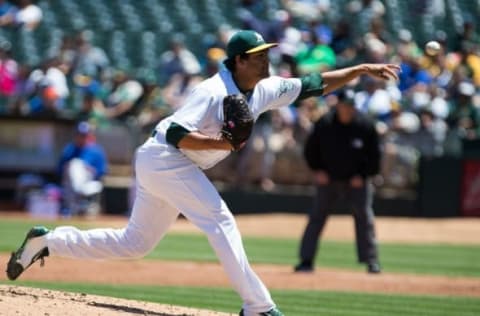
The traded arms
That inability to develop their own top of the rotation starters has caused the Kansas City Royals to make several trades over the past few seasons. Pitchers like James Shields and Johnny Cueto were brought in to help bring the Royals to respectability and to win a World Series title, while Wade Davis has turned into one of the best relievers in baseball. As the Royals have made consecutive World Series appearances, one can hardly argue with those moves.
Jake Odorizzi, who was packaged with Wil Myers, Montgomery, and Patrick Leonard, originally came over as part of the Greinke deal. Universally regarded as a Top 100 prospect from 2011 through 2014, He has yet to reach that potential. Odorizzi has settled in as a solid middle of the rotation starter, but at 26 years of age, that may be his ceiling. Montgomery, meanwhile, finally made the Majors with the Seattle Mariners, where he appears to have found himself as a solid option in the bullpen.
Sean Manaea, who the Royals traded to Oakland for Ben Zobrist, has shown flashes of brilliance during his rookie season, but has also struggled. A consensus Top 100 prospect over the past two years, Manaea has a 3-5 record with a 5.24 ERA and a 1.388 WHiP. There are certainly signs that the best is yet to come, as he has displayed solid control while striking out over seven batters per nine innings, making it possible that he will be the pitcher the Royals regret trading away.
Then there are the arms sent to Cincinnati for Johnny Cueto. John Lamb, after years of struggling to regain his form following Tommy John surgery, finally made the Majors, but has been mediocre at best, posting a 2-12 record with a 6.17 ERA and a 1.604 WHiP. Perhaps he could be useful out of the bullpen, but he appears to be minor league depth.
Cody Reed has also struggled, but at 23 years of age, has a chance to turn his career around. His 8.39 ERA and 1.865 WHiP may not impress, but Reed has a live arm and plenty of potential. Meanwhile, Brandon Finnegan appears to be the best piece the Reds received, pitching relatively well now that he is entrenched in the starting rotation. His walk rate is higher than Cincinnati would like, but he also has displayed the competitiveness that shows he could well develop into that starter the Reds are hoping for.
All in all, even the pitchers that the Royals have traded away have not reached their potential. There is still plenty of time for Manaea and Finnegan to get there, but the results for the vast majority of these arms have been disappointing.
Next: The ones that stayed
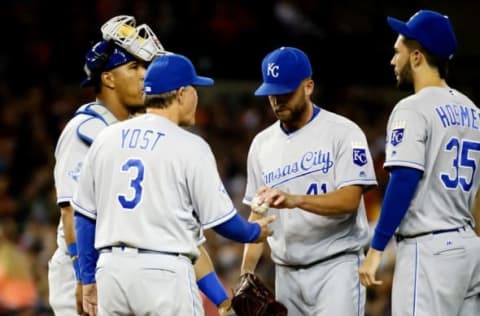
A Royal Enigma
Perhaps the two best pitchers that the Kansas City Royals have developed over the past decade are the ones that remain in their starting rotation. However, even those two have been a source of frustration and potential that remains untapped.
Danny Duffy, who may well be the best starter on the Royals this year, has tantalised for quite some time, and may have finally gotten himself figured out. He appeared to have his breakout campaign in 2014, when his 9-12 record belied a 2.53 ERA and a 1.112 WHiP. He started out the season in the bullpen, and when he moved back into the rotation, continued to attack the zone and trust his stuff. He thought less about what he was doing, and just fired away to great effect.
After struggling last year, and opening the 2016 campaign in the bullpen once again, Duffy looks like the 2014 incarnation once more. He has pitched like an ace, posting a 3.27 ERA and a 1.068 WHiP, striking out 101 batters against 18 walks in 88 innings of work. Once again, he is attacking the opposition, trusting his stuff and not fretting about any mistakes he makes. This is the Duffy that the Royals have been waiting for.
On the other side of the coin is Yordano Ventura. He certainly appears to have the pure stuff to be the staff ace that the Royals keep trying to turn him into, with a fastball that hits triple digits, but there are plenty of questions about his emotional and mental makeup. It is easy to lure Ventura into losing his cool, to the point where beanballs, brawls and ejections are a part of his package.
Even though it seems that Ventura needs to pitch angry, the results have not been there. This season, in particular, has been a disappointment, as he has struggled to a 5.15 ERA and a 1.420 WHiP. Even his strikeouts are down, as he has a career low 6.6 K/9, to go along with a high 3.8 BB/9. At some point, the Royals may run out of patience with their tantalizing, but infuriating, talent.
This is why the Kansas City Royals have had to continually look outside the organization to not only shore up their rotation, but to find a front line starter. Will that change in the future?
Next: Is there hope in the future?
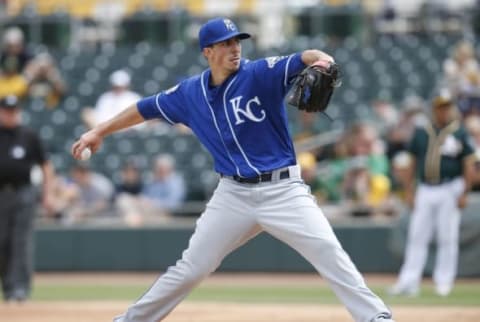
The Prospects
If the Royals are to be able to reverse this trend of disappointing results when it comes to minor league starters, it may be a few years down the road.
Kyle Zimmer has universally been regarded as one of the more intriguing arms in the minor leagues. A Top 100 prospect in each of the past four seasons, his excellent stuff and upper 90’s fastball would appear to be what top of the rotation starters are made of. However, he has yet to remain healthy over the course of a full season, making it fair to wonder if his arm can hold up as a starter. Otherwise, he may be a stellar reliever, but that would leave him as another pitcher who just could not be the ace the Kansas City Royals hoped for.
Miguel Almonte, meanwhile, has been healthy, but has struggled over the past couple of seasons. Considered a Top 100 prospect by MLB.com and BaseballProspectus heading into last season, Almonte disappointed, posting a 4.51 ERA and a 1.350 WHiP across two levels. However, as a 22 year old getting his first taste of AAA action, these woes were to be expected.
Back in AAA to start the 2016 campaign, Almonte has not progressed as one would have hoped for. His 5.03 ERA is a slight improvement from his mark last season in Omaha, but Almonte also has a 1.714 WHiP and an unsightly 38 walks in 53.2 innings. It has gotten to the point where he was yanked from the rotation in hopes that he can rediscover his command.
Perhaps the best bet for the Royals to find those needed arms will be an unheralded prospect. Jake Junis has been impressive at Northwest Arkansas, the Royals AA affiliate, posting a 9-4 record with a 2.76 ERA and a 1.096 WHiP, striking out 97 batters in 97.2 innings of work. He is likely to reach AAA Omaha in short order if he continues this preformance, and may even get a look as a September callup.
Otherwise, unless Zimmer can get healthy and Almonte can get back on track, the Royals may have to wait for Ashe Russell and Nolan Watson, their top picks in last year’s draft. If so, the Royals may need to build their rotation from the outside for some time.
Next: Where do they go from here?
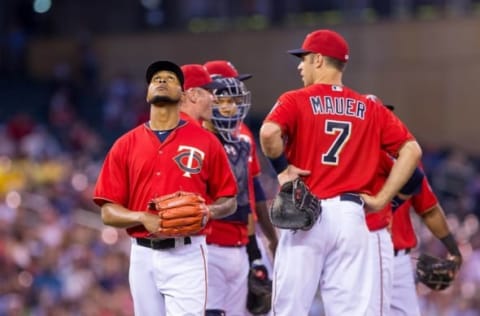
Trying to find a solution
This leads us back to the crux of the Royals problems – trying to find pitchers that can provide six solid innings and get to the bullpen. The problem is, that since they have not been able to develop that type of pitcher on their own, the Royals will need to either spend in free agency or on the trade market to bring those players in.
For the most part, the Royals have done well in free agency, although it really does not show this year. Edinson Volquez, prior to his struggles this season, had been quite the bargain. Ian Kennedy looks like he belongs in Kansas City, his issues with the home run notwithstanding. Ervin Santana did well as a reclamation project in 2013. Even Chris Young and Kris Medlen were solid last year.
The problem is that those players are not performing at the same level again this year. Young and Medlen have dealt with injuries, but have generally been ineffective when healthy. In particular, Young has been a disaster, looking more like someone who was auditioning to pitch in the Home Run Derby than to get outs in the Majors.
And so, the Royals are back in a familiar place, looking outside the organization for that arm that can solidify their rotation. Santana is considered a possibility, although he has two more years at $28 Million left on his contract after this year. Matt Moore is another possibility, as he has a more team friendly deal, but he has not been effective. Will a change of scenery alter his course?
Then there is the ultimate prize of Sonny Gray. Under team control through 2020, the ace of the A’s is considered the top pitcher that could be available. While Oakland has stated they do not wish to part with the righty, they may well receive quite the package of prospects if they change their minds. Considering that Drew Pomeranz was worth a top 20 prospect in all of baseball, Gray could well be a game changer for the A’s.
Of course, this would likely price the Royals out of any of those players. Their farm system is almost barren, and unless a team wants to take a chance on Zimmer suddenly becoming healthy, or the resurgence of Bubba Starling and Hunter Dozier, there just is not much left after those other trades. It looks like the Royals are destined to hunt for bargains again in free agency next year.
Next: Chicago White Sox hunt for a center fielder
Chances are, the Kansas City Royals will not be able to improve their rotation this year. That quest for the elusive starting pitcher that can change the Royals appears as though it will continue for quite some time, barring unforeseen circumstances.